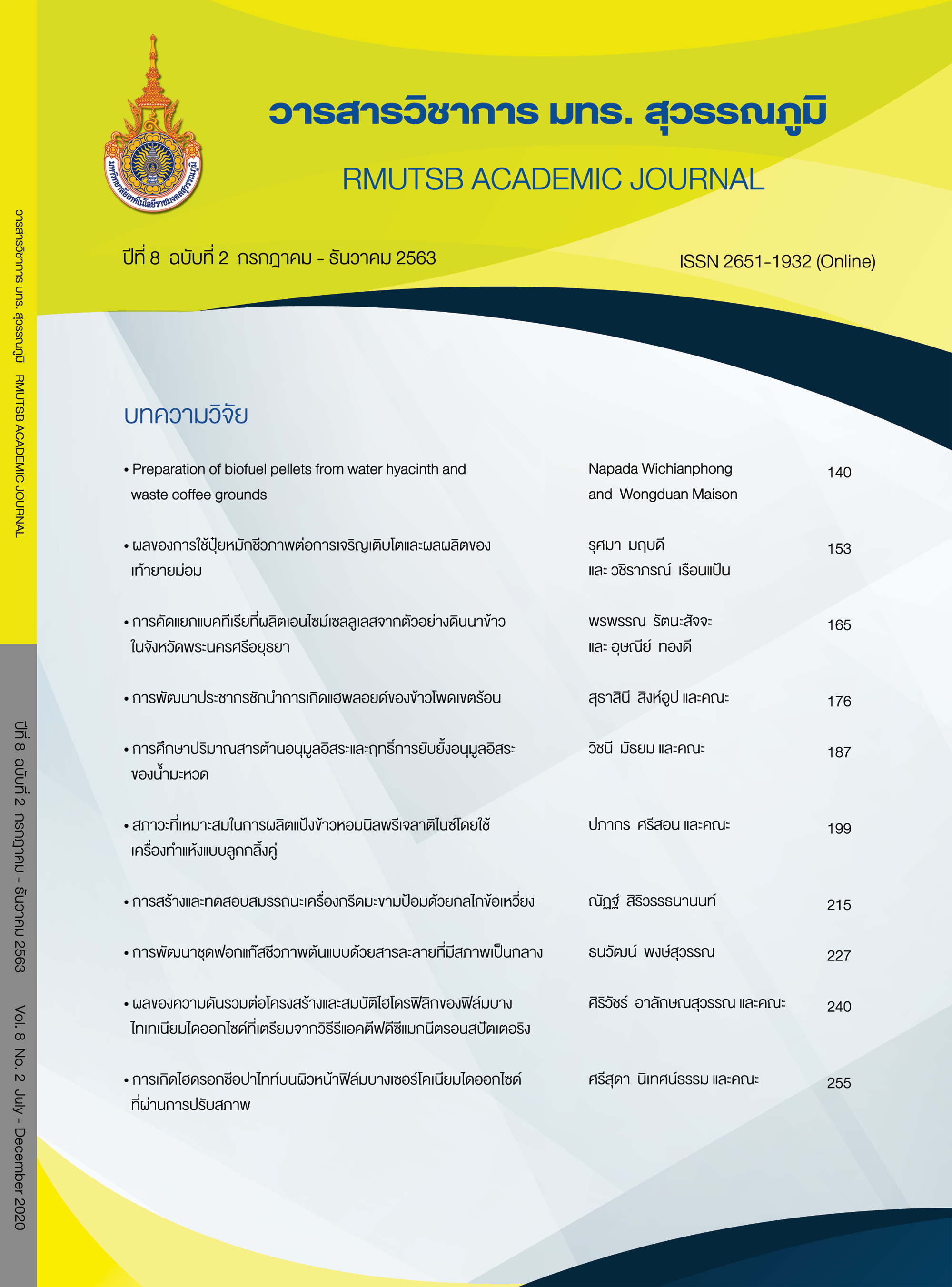Investigation of antioxidant capacity and antioxidant activity of Ma-huad (Lepisanthes rubiginosa (Roxb.) Leenh.) juice
Main Article Content
Abstract
Ma-huad (Lepisanthes rubiginosa (Roxb.) Leenh.) is a perennial plant of the Sapindaceae family. This plant has been found in the sparse forest of Thailand and neighboring countries. The color of ripe Ma-huad fruits is red - purple and the active substances found in this fruit are anthocyanins. Furthermore, others polyphenols, may be found as constituents in this plant. In the present study, antioxidant contents and antioxidant activity of Ma-huad juices were determined. Preparation of Ma-huad juices was done by using the ratio of ripe Ma-huad fruit weight and distilled water into 1:1, 1:2 and 1:3, respectively. The boiling temperature was controlled at 95 oC while the boiling times were changed from 5 to 15 minutes (5-minute intervals). Some physical properties of Ma-huad juices were analyzed. These samples were determined for total anthocyanin content by using pH-differential method, total phenolic content by using Folin-Ciocalteu reagent, antioxidant activity by DPPH and ABTS assays. The results showed that the maximum total anthocyanin contents, total phenolic contents and antioxidant activities from DPPH and ABTS methods were 86.00±1.77 mg CGE/100g of FW, 118.64±1.40 mg GAE/100 g crude extract, 57.78%, and 96.62%, respectively which was obtained from T3 sample (ratio of ripe Ma-huad fruit weight and distilled water was 1:1 at 15 minutes). Total anthocyanin contents and total phenolic contents were highly correlated to the percentage of the inhibition of antioxidant activity both DPPH assay (r=0.82 and 0.88) and also ABTS assay (r=0.64 and 0.72) at 0.05 significance (p>0.05).
Article Details
Published manuscript are the rights of their original owners and RMUTSB Academic Journal. The manuscript content belongs to the authors' idea, it is not the opinion of the journal's committee and not the responsibility of Rajamangala University of Technology Suvarnabhumi
References
Aninbon, C., Banterng, P., Sanitchon, J., & Songsri, P. (2011). A study of anthocyanin content in black glutinous rice using HPLC and spectrophotometric methods. Khonkaen AGR. J., 39(Special issue), 353-357.
BGO Plant Databases, The Botanical Garden Organization. (n.d.). Mahuad. Retrieved 20 January 2018, from http://www.qsbg.org/database/botanic_book20full%20option/search_detail.asp?botanic_id=1497 (in Thai)
Cabrita, L., Fossen, T., & Andersen, O. M. (2000). Colour and stability of the six common anthocyanidin 3-glucosides in aqueous solutions. Food Chem., 68, 101-107.
Chaovanalokit, A. (2011). Extraction and analysis of anthocyanin. SWU J Sci. & Tech., 6, 26-36. (in Thai)
Choudhury, A. K. R. (2014). Principles of colour and appearance measurement. Cambridge: Woodhead.
Diaconeasa, Z., Ranga, F., Rugina, D., Leopold, L., Pop, O., Vodnar, D., Cuibus, L., & Socaciu, C. (2015). Phenolic content and their antioxidant activity in various berries cultivated in Romania. Bulletin UASVM Food Sci. & Tech., 72(1), 99-103.
Giusti, M. M., & Wrolstad, R. E. (2001). Characterization and measurement of anthocyanins by UV-visible spectroscopy. Current Protocols in Food Analytical Chemistry, 00(1), F1.2.1-F1.2.13.
Hurtado, N. H., Morales, A. L., Gonzalez-Miret, M. L., & Escudero-Gilete, M. L. (2009). Color, pH stability and antioxidant activity of anthocyanin rutinosides isolated from tamarillo fruit (Solanum betaceum Cav.). Food Chem., 117, 88-93.
Kriengsak, T., Boonprakob, U., Crosby, K., Cisneros-Zevallos, L., & Byrne, D. H. (2006). Comparison of ABTS, DPPH, FRAP, and ORAC assays for estimating antioxidant activity from guava fruit extracts. J. Food Comp. Anal., 19, 669-675.
Lee, J., Durst, R. W., & Wrolstad, R. E. (2005). Determination of total monomeric anthocyanin pigment content of fruit juices, beverages, natural colorants, and wines by the pH differential method: Collaborative study. J. AOAC Int., 88(5), 1269-1278.
Lourith, N., Kanlayavattanakul, M., & Chanpirom, S. (2009). Free radical scavenging efficacy of tamarind seed coat and its cosmetics applications. J. Health Res., 23, 159-162.
Pajareon, S. (2019). Stability of anthocyanin extract from riceberry rice bran encapsulated with rice bran protein concentrate under different pH and heating conditions. RMUTSB Academic Journal, 7(2), 205-215. (in Thai)
Pimrote, K., Teekayu, K., & Sudprasert, P. (2020). Antioxidant activity and inhibition effect on Pseudomonas aeruginosa of extracts from Pa-Yom (Shorea roxburghii G. Don). RMUTSB Academic Journal, 8(1), 15-27. (in Thai)
Roobha, J. J., Saravanakumar, M., Aravindhan, K. M., & Devi, P. S. (2011). The effect of light, temperature, pH on stability of anthocyanin pigments in Musa acuminata bract. Res. Plant Biol., 1, 5-12.
Shafazila, T. S., Pat, M. L., & Lee, K. H. (2010). Radical scavenging activities of extract and solvent-solvent partition fractions from Dendrobium Sonia ‘Red Bom’ flower. In Proceeding of International Conference on Science and Social Research (pp. 762-765). Kuala Lumpur, Malaysia: Universiti Teknologi MARA.
Sonchai, B. (2009). Study on the radical scavenging activity of Lepisanthes rubiginosa (Roxb.) Leenh. wine and Melodorum fruticosum Lour. Wine (Master’s thesis). Ubon Ratchathani Rajabhat University, Ubon Ratchathani.
Thai industrial standards institute (TISI). (2006). Draft Thai industrial standards (TIS 112-2549) fruit juice: pine juice. Retrieved 20 January 2018, from http://appdb.tisi.go.th/tis_dev/p3_tis/p3tis.php (in Thai)
Wangcharoen, W., & Morasuk, W. (2007). Antioxidant capacity and phenolic content of holy basil. Songklanakarin J. Sci. Technol., 29(5), 1407-1415.
Wetwitayaklung, P., Charoenteeraboon, J., Limmatvapirat, C., & Phaechamud, T. (2012). Antioxidant activities of some Thai and exotic fruits cultivated in Thailand. RJPBCS, 3(1), 12-21.


